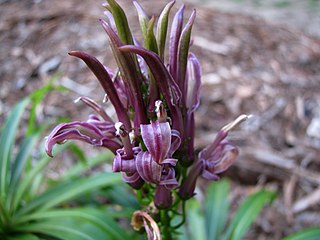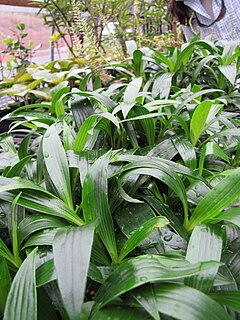
The nene, also known as nēnē and Hawaiian goose, is a species of bird endemic to the Hawaiian Islands. The official bird of the state of Hawaiʻi, the nene is exclusively found in the wild on the islands of Oahu, Maui, Kauaʻi, Molokai, and Hawaiʻi.
Hawaiian hibiscus are seven species of hibiscus native to Hawaii. The yellow hibiscus is Hawaii's state flower. Most commonly grown as ornamental plants in the Hawaiian Islands are the Chinese hibiscus and its numerous hybrids, though the native Hibiscus arnottianus is occasionally planted.

The Hawaiian lobelioids are a group of flowering plants in the bellflower family, Campanulaceae, all of which are endemic to the Hawaiian Islands. This is the largest plant radiation in the Hawaiian Islands, and indeed the largest on any island archipelago, with over 125 species. The six genera can be broadly separated based on growth habit: Clermontia are typically branched shrubs or small trees, up to 7 metres (23 ft) tall, with fleshy fruits; Cyanea and Delissea are typically unbranched or branching only at the base, with a cluster of relatively broad leaves at the apex and fleshy fruits; Lobelia and Trematolobelia have long thin leaves down a single, non-woody stem and capsular fruits with wind-dispersed seeds; and the peculiar Brighamia have a short, thick stem with a dense cluster of broad leaves, elongate white flowers, and capsular fruits.

Charpentiera is a flowering plant genus in the family Amaranthaceae. It consists of five species endemic to Hawaiʻi, where they are known as pāpala, and one species found only on the island of Tubuai in the Austral Islands. All species are trees, some reaching more than 10 metres (33 ft) in height. The genus is named for Arsène Charpentier (1781-1818), professor of pharmacy at Antwerp from 1810 to 1814 and at Cherbourg from 1814 to 1816.

Wikstroemia is a genus of 55-70 species of flowering shrubs and small trees in the mezereon family, Thymelaeaceae. Hawaiian species are known by the common name ‘ākia.

Cenchrus agrimonioides is a rare species of grass in the family Poaceae that is endemic to the Hawaiian Islands. Its common names include Kāmanomano and agrimony sandbur. It was formerly distributed throughout the major islands but today it is nearly limited to Oʻahu. Kāmanomano inhabits dry to moist forests and lava plains. It is threatened by competition with non-native plants, predation by ungulates, and wildfire. When this plant became a federally listed endangered species of the United States in 1996 there were fewer than 100 individuals remaining. More recent counts revealed 181 wild individuals on Oʻahu and over 300 more which have been planted to augment the populations. This plant is nearly restricted to the island of Oʻahu, but there are a few individuals known on Maui. A few patches of the grass have been planted on Kahoʻolawe, as well.
Phyllostegia kaalaensis, the Kaala phyllostegia, is a species of flowering plant in the mint family, Lamiaceae, that is endemic to the island of Oʻahu in Hawaiʻi. It can be found in mesic forests on the slopes of the Waiʻanae Range at elevations of 374–796 metres (1,227–2,612 ft).

Phyllostegia is a genus of flowering plant in the mint family, Lamiaceae, first described in 1840. It is native to certain islands in the Pacific.
- Phyllostegia ambigua(A.Gray) Hillebr - Hawaii Big Island, Maui
- Phyllostegia bracteataSherff - Maui
- Phyllostegia brevidensA.Gray - Hawaii Big Island, Maui
- Phyllostegia electraC.N.Forbes - Kauai
- Phyllostegia floribundaBenth - Hawaii Big Island
- Phyllostegia glabra (Gaudich.) Benth. - Hawaiian Islands
- Phyllostegia grandiflora(Gaudich.) Benth - Oahu
- Phyllostegia haliakalaeWawra - Maui, Molokai
- Phyllostegia helleriSherff - Wai'alae Valley of Kauai
- †Phyllostegia hillebrandiiH.Mann ex Hillebr - Maui but extinct
- Phyllostegia hirsutaBenth. - Oahu
- Phyllostegia hispidaHillebr. - Molokai
- Phyllostegia kaalaensisH.St.John - Oahu
- Phyllostegia kahiliensisH.St.John - Kauai
- Phyllostegia knudseniiHillebr. - Kauai
- Phyllostegia macrophylla(Gaudich.) Benth. - Hawaii Big Island, Maui
- Phyllostegia manniiSherff - Molokai, Maui
- Phyllostegia micranthaH.St.John - Oahu
- Phyllostegia mollisBenth. - Hawaiian Islands
- Phyllostegia parvifloraBenth. - Hawaiian Islands
- Phyllostegia pilosaH.St.John - Hawaiian Islands
- Phyllostegia racemosaBenth. - Hawaiian Islands
- Phyllostegia renovansW.L.Wagner - Kauai
- †Phyllostegia rockiiSherff - Maui but extinct
- Phyllostegia stachyoidesA.Gray - Hawaiian Islands
- †Phyllostegia tahitensisNadeaud - Tahiti but extinct
- Phyllostegia tongaensisH.St.John - Tonga
- †Phyllostegia variabilisBitter - Midway Islands but extinct
- Phyllostegia velutina(Sherff) H.St.John - Hawaii Big Island
- Phyllostegia vestitaBenth. - Hawaii Big Island
- Phyllostegia waimeaeWawra - Kauai
- Phyllostegia warshaueriH.St.John - Hawaii Big Island
- Phyllostegia wawranaSherff - Kauai
- Phyllostegia × yamaguchiiHosaka & O.Deg. - Oahu (P. glabra × P. hirsuta)

Phyllostegia mollis, the Waianae Range phyllostegia, is a species of flowering plant in the mint family, Lamiaceae, that is endemic to Hawaiʻi. It can be found in mesic and wet forests at elevations of 450–1,830 metres (1,480–6,000 ft) on the islands of Maui and Oʻahu. Some authors consider it to be an Oahu endemic, with the Maui populations belonging to a separate species, Phyllostegia pilosa. By 2003 there were fewer than 40 individuals remaining. It is threatened by habitat loss.

Alectryon macrococcus, known as ʻAlaʻalahua or Māhoe in Hawaiian, is a species of flowering tree in the soapberry family, Sapindaceae, that is endemic to Hawaii.

Euphorbia skottsbergii is a rare species of flowering plant in the euphorb family known by the common names coastal sandmat and Skottsberg's broomspurge. It is endemic to Hawaii, where it is found in coastal shrublands on Oʻahu, Molokaʻi, Maui, and Kahoʻolawe. Like other Hawaiian euphorbs, this plant is known locally as ʻakoko.

Lipochaeta lobata is a species of flowering plant in the aster family known by the common name shrubland nehe. It is endemic to Hawaii, where it can be found in coastal dry shrublands and dry forests on Oʻahu, Maui, and Niʻihau.

Cyperus pennatiformis is a rare species of sedge known by the common name coastal flatsedge. It is endemic to Hawaii, where it grows on the islands of Maui, Kauai, and Laysan. It is a federally listed endangered species of the United States.
Phyllostegia glabra is a species of flowering plant in the mint family known by the common name ulihi phyllostegia. It is endemic to Hawaii.
Phyllostegia hirsuta is a species of flowering plant in the mint family known by the common names Molokai phyllostegia and hairy phyllostegia. It is endemic to Hawaii, where it is known only from the island of Oahu. It is a federally listed endangered species of the United States.
Phyllostegia mannii is a rare species of flowering plant in the mint family known by the common name Mann's phyllostegia. It is endemic to Hawaii, where it has been known from Maui and Molokai. It has not been observed on Maui since the early 20th century, or on Molokai since 1993, but it probably still exists in unsurveyed areas. It is a federally listed endangered species of the United States.
Phyllostegia waimeae is a rare species of flowering plant in the mint family known by the common name Kauai phyllostegia. It is endemic to Hawaii, where it is limited to the island of Kauai. It is a federally listed endangered species of the United States.

Plantago princeps is a rare species of flowering plant in the plantain family known by the common name ale. It is endemic to Hawaii, where it is known from the islands of Hawaii, Kauai, Oahu, Molokai, and Maui. Like other Hawaiian Plantago, it is known as kuahiwi laukahi, or laukahi kuahiwi. It is a federally listed endangered species of the United States.
Sanicula purpurea is a rare species of flowering plant in the carrot family known by the common names purple-flower black-snakeroot and purple-flowered sanicle. It is endemic to Hawaii, where it is known from Maui and from the Koolau Mountains on the island of Oahu. It is threatened by the degradation of its habitat. It was federally listed as endangered species of the United States in 1996.













